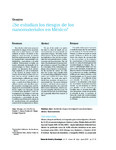
Please use this identifier to cite or link to this item:
http://ricaxcan.uaz.edu.mx/jspui/handle/20.500.11845/282Full metadata record
| DC Field | Value | Language |
|---|---|---|
| dc.contributor | 211647 | |
| dc.contributor.other | 0000-0002-7441-3233 | |
| dc.coverage.spatial | México | es_ES |
| dc.creator | Záyago Lau, Edgar | |
| dc.creator | Foladori, Guillermo | |
| dc.creator | Frederick, Stacey | |
| dc.creator | Arteaga Figueroa, Edgar | |
| dc.date.accessioned | 2017-06-05T13:24:29Z | |
| dc.date.available | 2017-06-05T13:24:29Z | |
| dc.date.issued | 2015-05 | |
| dc.identifier | info:eu-repo/semantics/publishedVersion | |
| dc.identifier.issn | 2007-0977 | es_ES |
| dc.identifier.uri | http://hdl.handle.net/20.500.11845/282 | |
| dc.description | The aim of this article is to explore the extent to which the health and environmental risks of nanomaterials are researched in Mexico. The article consists of four sections. The first section illustrates the implications of the risks that nanoparticles and nanomaterials pose to workers, consumers and the environment. Next, the state of the development of nanotechnologies in Mexico is reviewed. This is followed by a description of the methodology employed, which is based on two techniques: the first involved the creation of a data base that contains every scientific article on nanotechnology published by Mexican authors over a period of 12 years. From his data base, key words were used to identify those associated with research on nanomaterial risk. The second technique involved a web-based internet search to identify all the researchers who work in this field in various laboratories, research centers and universities within the country. We conclude that the topic of nanotechnology risk is generally absent from research in Mexico. | es_ES |
| dc.description.abstract | Este artículo evalúa hasta qué punto se estudian los riesgos de los nanomateriales para la salud humana y el medio ambiente en México. El artículo se despliega en cuatro secciones. La primera ilustra las implicaciones de los riesgos de las nanopartículas y nanomateriales a los trabajadores, consumidores y el medio ambiente. Posteriormente se realiza una revisión del estado de desarrollo de las nanotecnologías en México. Después se plantea una descripción de la metodología empleada, la cual se fundamentó en dos técnicas: la primera implicó la creación de una base de datos que contiene todos los artículos científicos sobre nanotecnologías publicados por autores mexicanos durante un período de 12 años, y a partir de esa base de datos se utilizaron términos para identificar aquellos asociados a investigaciones sobre los riesgos de los nanomateriales; la segunda técnica implicó una búsqueda manual en Internet para identificar a todos los investigadores que trabajan en esta área en los distintos laboratorios, centros de investigación y universidades del país. Concluimos que el tema de los riesgos de las nanotecnologías está generalmente ausente de las investigaciones en México. | es_ES |
| dc.language.iso | spa | es_ES |
| dc.publisher | Universidad Tecnológica de la Mixteca | es_ES |
| dc.relation | http://www.utm.mx/edi_anteriores/temas56/index.html | es_ES |
| dc.relation.uri | generalPublic | es_ES |
| dc.rights | openAccess | es_ES |
| dc.rights.uri | http://creativecommons.org/licenses/by-nc-sa/3.0/us/ | * |
| dc.source | Temas de Ciencia y Tecnología vol. 19 número 56 Mayo - Agosto 2015 pp 17 -27 | es_ES |
| dc.subject.classification | TECNOLOGÍA Y CAMBIO SOCIAL [6] | es_ES |
| dc.subject.other | info:eu-repo/classification/Análisis de riesgos | |
| dc.subject.other | info:eu-repo/classification/Nanotecnología - Investigación - México | |
| dc.subject.other | info:eu-repo/classification/Nanomateriales. | |
| dc.title | ¿Se estudian los riesgos de los nanomateriales en México? | es_ES |
| dc.type | article | es_ES |
| Appears in Collections: | *Documentos Académicos*-- UA Estudios del Desarrollo | |
Files in This Item:
| File | Description | Size | Format | |
|---|---|---|---|---|
| 17 Edgar ZayagoSe estudian riesgos Riesgos en Mexico.pdf | 178,59 kB | Adobe PDF |  View/Open |
This item is licensed under a Creative Commons License
